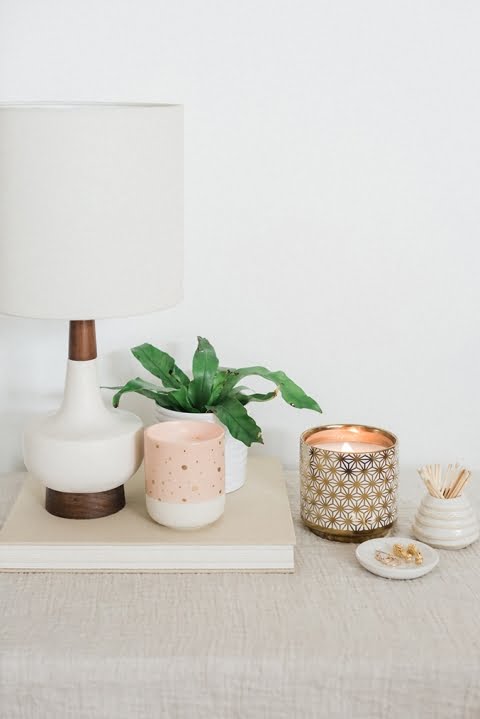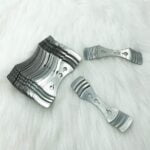Learning how to clean up after making wax candles is an essential skill for any candle enthusiast. The process of creating beautiful and fragrant candles can be messy, leaving behind residual wax on surfaces, equipment, and even clothing.
Understanding how to effectively tackle this cleanup not only ensures a tidy workspace but also prolongs the lifespan and quality of your candle-making materials. In this blog post, we will provide step-by-step instructions on how to clean up after making wax candles, along with tips for safe and convenient cleanup.
Making wax candles is a satisfying hobby that allows you to express your creativity while filling your space with delightful scents. However, it’s no secret that the candle-making process can result in quite the mess. Drips and spills are inevitable, and if not properly cleaned up, they can cause damage to various surfaces or fabric items. That’s why knowing how to remove wax residue without causing further harm becomes crucial.
Our blog post will guide you through each stage of the cleaning process, starting with preparing for cleanup by gathering necessary supplies and creating a designated workspace. We will then delve into the specifics of removing wax residue from different surfaces using appropriate techniques such as heat or cold methods. Additionally, we will address cleaning reusable candle-making equipment and treating stains on clothing or fabric resulting from wax spills.
By following our comprehensive guide, you will also learn effective ways to degrease surfaces affected by wax, clean up wax splatters without damaging surrounding areas, and dispose of waste responsibly. Through maintaining a tidy workspace after making wax candles, you not only ensure safety but also create an environment conducive to future candle-making projects.
Join us in exploring the world of post-candle-making cleanup as we provide invaluable tips and tricks for maintaining cleanliness before embarking on your next creative endeavor.
Preparing for Clean-up
Before starting the clean-up process, it is important to gather all the necessary supplies. This will ensure that you are well-prepared and can tackle any mess effectively. Some basic supplies you will need include gloves, garbage bags, paper towels, and cleaning agents suitable for different surfaces. Additionally, having a designated workspace for clean-up will make the process more organized and efficient.
Gathering Necessary Supplies
To start preparing for clean-up after making wax candles, gather all the essential supplies in one place. This will save you time and effort during the actual cleaning process. Here are some supplies you may need:
- Gloves: Wearing gloves will protect your hands from any chemicals or stains while cleaning.
- Garbage bags: Keep several garbage bags nearby to dispose of any waste materials, such as used paper towels or excess wax.
- Paper towels or microfiber cloths: These absorbent materials are ideal for wiping up spills and removing wax residue from surfaces.
- Cleaning agents: Depending on the type of surface you need to clean, have suitable cleaning agents handy. For example, use mild soap and water for most surfaces, but specific cleaners may be required for more stubborn stains or delicate materials.
Creating a Designated Workspace
Designating a specific area for clean-up will help keep your surroundings organized and prevent messes from spreading throughout your home. Find a space with good lighting and a flat surface where you can efficiently work on removing wax residue. Lay down some protective covering, like old newspapers or plastic sheets, to catch any drips or spills during the clean-up process.
Tips for Safety and Convenience
As you embark on cleaning up after making wax candles, keep safety in mind by following these tips:
- Ensure good ventilation in your designated workspace to prevent inhaling fumes from cleaning agents.
- Do not clean hot wax spills immediately, as it may cause burns. Allow the wax to cool and solidify before removal.
- Be cautious around electrical equipment and outlets while cleaning to prevent any accidents or damage.
By taking these steps to prepare for clean-up, you are setting yourself up for an effective and efficient process. With the necessary supplies and an organized workspace, you can tackle the mess left behind by candle-making with ease.
Removing Wax Residue
Step-by-step guide on removing any spilled or dripped wax
After making wax candles, it is common to have spills or drips of wax on various surfaces. Removing these wax residues promptly can help maintain a clean and organized workspace. Here is a step-by-step guide on how to remove wax residue effectively:
First, let the spilled or dripped wax cool completely. Trying to remove hot wax may cause further damage or spread the mess. Once the wax has hardened, gently scrape off as much as possible with a plastic scraper or credit card, being careful not to scratch the surface.
Next, apply heat to soften the remaining wax. For hard surfaces like countertops or floors, you can use a hairdryer on low heat setting and aim it at the area with wax residue. The heat will melt the wax and make it easier to wipe away.
For fabric or clothing with wax residue, place a paper towel over the affected area and iron over it using a low-heat setting. The heat from the iron will cause the remaining wax to transfer onto the paper towel.
Different techniques for various materials
Different materials require different techniques for removing wax residue:
- Wood: For wooden surfaces, such as furniture or floors, take extra caution not to cause any damage. Scrape off as much hardened wax as possible using a plastic scraper or credit card. Then, place an ice pack wrapped in a cloth over the remaining residue to harden it further. Once hardened again, carefully scrape off any additional bits of wax. Finally, wipe down with a cloth dampened in warm soapy water and dry thoroughly.
- Countertops: For countertops made of materials like granite or marble, avoid using sharp tools that could scratch them. Follow similar steps mentioned above for wood surfaces – scrape off excess hardened wax gently and then use an ice pack method if needed. Cleanse countertops with a non-abrasive cleaner recommended for the specific material.
- Fabric: When dealing with fabric, removing excess wax is crucial. Gently scrape off any hardened wax and place a brown paper bag or absorbent cloth over the affected area. Using an iron on low heat, press it over the paper bag, which will absorb the melted wax.
Repeat this process until no more wax transfers onto the paper bag. If some residue remains, treat it with a stain remover suitable for the fabric type before laundering as usual.
Use of heat or cold to facilitate wax removal
Heat and cold are both useful in facilitating wax removal:
- Heat: Applying heat to soften the remaining wax makes it easier to remove. As mentioned earlier, using a hairdryer on low heat setting or ironing over a paper towel placed on fabric are effective ways to apply heat.
- Cold: Freezing can also help remove stubborn wax residue from certain surfaces. For example, if there is spilled candle wax on glass or ceramic, place an ice pack or ice cubes wrapped in a plastic bag over the affected area until it hardens completely. Then gently scrape off the hardened wax with a plastic scraper or credit card.
By following these techniques and utilizing heat or cold when necessary, you can effectively remove wax residue from various surfaces without causing further damage or leaving behind stains.
Cleaning Candle-Making Equipment
One important aspect of cleaning up after making wax candles is properly cleaning the equipment used in the candle-making process. This includes reusable equipment such as double boilers, wax melting pots, and pouring containers. Properly cleaning these items ensures that they are ready for future use and helps maintain their longevity.
To clean candle-making equipment, start by emptying any remaining wax from the equipment into a heat-resistant container. If the wax is still liquid, be sure to allow it to cool and solidify before attempting to remove it. Once the excess wax has been removed, fill a sink or basin with hot water and add some dish soap or a specific cleaning agent recommended for candle-making equipment.
Next, submerge the equipment in the soapy water and use a sponge or cloth to scrub away any remaining wax residue. Pay extra attention to hard-to-reach areas or crevices where wax can accumulate. For stubborn residue, you may need to let the equipment soak in the soapy water for a while before scrubbing again. Rinse thoroughly with clean water to remove any soap residue.
Some candle-making equipment may require additional cleaning steps depending on their material composition or design. For example, if you are using silicone molds or containers, be cautious when using abrasive materials that could damage them. Instead, opt for gentle scrubbing with soft brushes or sponges.
Properly cleaning your candle-making equipment not only extends its lifespan but also ensures that your future candle batches have optimal quality. Regular maintenance of your equipment will save you time and money in the long run by preventing build-up and potential contamination of your candles.
Treating Stains on Clothing or Fabric
When making wax candles, it is not uncommon to accidentally get wax stains on clothing or fabric. However, with the right methods and techniques, these stains can be successfully removed without causing any damage. It is important to address these stains as soon as possible to prevent them from setting in and becoming more difficult to remove. In this section, we will provide instructions for treating wax stains on different types of fabric.
Firstly, it is important to remove any excess wax before attempting to treat the stain. To do this, place the stained fabric in the freezer for a few hours until the wax hardens. Once hardened, gently scrape off as much of the excess wax as possible using a dull knife or your fingernail.
Next, place a clean brown paper bag or several layers of absorbent materials, such as paper towels or cotton cloths, over the stain. Then, using a warm iron set to a low temperature (to avoid melting synthetic fibers), press down firmly and continuously over the area with the stain.
The heat will help transfer the remaining wax from the fabric onto the paper bag or absorbent material. Remember to continually shift to clean parts of the paper bag or change out the absorbent materials until no more wax transfers onto them.
After removing as much wax as possible, there may still be some discoloration left behind on your fabric. For natural fabrics such as cotton or linen, you can create a poultice by mixing equal parts water and laundry detergent into a paste-like consistency. Apply this mixture directly onto the stain with a soft brush or your fingers and let it sit for about 15 minutes before washing according to care instructions.
For delicate fabrics like silk or wool, it is best to take them to a professional dry cleaner and inform them of the specific stain so they can use their expertise and specialized solvents for removal.
By following these steps, you can effectively treat wax stains on clothing or fabric. Remember to always check the care labels on your fabric before attempting any stain removal technique and, if unsure, it is advisable to seek professional help to avoid damaging your items.
| Fabric Type | Treatment Method |
|---|---|
| Cotton or Linen | Create a poultice using equal parts water and laundry detergent. Apply onto the stain and wash according to care instructions. |
| Silk or Wool | Take to a professional dry cleaner and inform them of the specific stain for specialized treatment. |
| Synthetic fabrics (polyester, nylon, etc.) | Follow the steps mentioned above for removing excess wax, then use a solvent-based stain remover according to product instructions. |
Degreasing Surfaces
When making wax candles, it’s common for greasy residue to be left behind on surfaces. To ensure a clean and tidy workspace, proper degreasing techniques are necessary. Here are some essential steps to remove greasy residue caused by wax:
- Identify the surface: The first step in degreasing is to identify the type of surface you are working with. Different surfaces may require different cleaning methods to prevent damage.
- Gather the appropriate cleaners: Choose a suitable cleaner based on the surface material. For non-porous surfaces like countertops, glass, or tile, general purpose household cleaners can be effective. For wood or delicate surfaces, consider using mild dish soap mixed with warm water.
- Apply the cleaner: Apply the chosen cleaner to an appropriate cleaning tool, such as a sponge or microfiber cloth. Gently scrub the greasy areas until the residue starts to lift.
- Rinse and dry: After scrubbing, rinse off the cleaner with clean water and wipe dry with a soft cloth to prevent water stains or further residue build-up.
It’s important to note that when working with certain materials like wood or porous stone, excessive moisture can cause damage. In these cases, it’s advisable to use only minimal amounts of water during cleaning and dry thoroughly afterward.
To prevent future wax build-up on surfaces, consider implementing these helpful tips:
- Use protective coverings: Place a protective covering over work surfaces before starting any candle-making project. This will make cleaning up easier and reduce the risk of stains or damage.
- Clean spills immediately: If any wax spills occur during the candle-making process, clean them up promptly to prevent them from hardening and becoming more difficult to remove later on.
- Regular maintenance: Incorporate regular cleaning and maintenance of candle-making equipment and surfaces into your routine. This will help prevent the build-up of wax residue over time.
By following proper degreasing techniques and implementing preventive measures, you can maintain a clean workspace free from wax residue and enjoy the satisfaction of creating candles in an organized environment.
Dealing with Wax Splatters
Cleaning up wax splatters can be a frustrating task, but with the right techniques, you can remove the residue without damaging your walls, furniture, or other surfaces. Here are some effective methods to deal with wax splatters:
- Scraping off Excess Wax: Before tackling the residue left behind by wax splatters, it’s important to scrape off any excess wax on the surface. Use a plastic scraper or a credit card to gently scrape away the hardened wax. Be careful not to scratch or damage the surface.
- Applying Heat: The heat from a hairdryer can be used to soften and remove wax splatters on surfaces such as walls or furniture. Set the hairdryer to medium heat and hold it several inches away from the splattered area. Move the hairdryer in circular motions until you notice the wax starting to melt. Once melted, quickly wipe away the softened wax with a clean cloth or paper towel.
- Using Solvents for Stubborn Residue: If there are stubborn wax stains leftover from splatters, you may need to use solvents to dissolve and remove them. Always test solvents on an inconspicuous area first to ensure they don’t cause damage or discoloration.
Rubbing alcohol, mineral spirits, or acetone can be effective in breaking down and removing tough wax residue. Apply a small amount of solvent onto a clean cloth and gently rub it over the stain until it disappears. - Prevention Measures: To avoid unnecessary splatters during the candle-making process, take preventive measures such as using a larger pouring container with a spout or covering nearby surfaces with newspaper or plastic sheets. You can also create barriers using aluminum foil or heat-resistant mats around your work area to catch any potential drips or spills.
By following these steps and using appropriate techniques, you can successfully clean up after dealing with wax splatters without causing any damage to your surfaces. Remember to always take precautionary measures and test any solvents on a small, inconspicuous area before applying them to larger surfaces.
Proper Disposal of Wax Waste
When it comes to making wax candles, it is important to not only enjoy the process but also take responsibility for proper waste management. Disposing of wax waste in an eco-friendly manner ensures that we minimize our environmental impact and contribute to a sustainable lifestyle. Here are some tips on how to properly dispose of wax waste:
- Recycling: One of the most common ways to dispose of wax waste is by recycling it. Before recycling, make sure to remove any non-biodegradable materials such as wicks or metal candle holders. Once these materials are removed, the wax can be melted down and repurposed into new candles or other products.
- Repurposing: Another option for disposing of wax waste is by repurposing it yourself. If you have leftover bits and pieces of used candles, you can melt them down and pour the melted wax into new candle molds or even use them for creating fire starters for camping trips or bonfires.
- Composting: If your candles are made from 100% organic and biodegradable materials such as beeswax or soy wax, you may consider composting them. Chop up the waste into small pieces to speed up the decomposition process, then add the wax scraps to your compost bin or pile. Over time, they will break down naturally and enrich your soil.
Taking these steps towards responsible waste management not only benefits the environment but also allows you to make full use of your candle-making materials and resources. By recycling or repurposing leftover wax, you can save money on buying new supplies while reducing landfill waste.
| Disposal Method | Description |
|---|---|
| Recycling | Separate non-biodegradable materials and melt down wax for reuse. |
| Repurposing | Melt down wax scraps to create new candles or fire starters. |
| Composting | For organic waxes, chop up scraps and add them to your compost bin or pile. |
By following these disposal methods, you can contribute to a cleaner and more sustainable environment while enjoying the art of candle-making. Remember, responsible waste management is not only about tidying up after making wax candles; it is a small but important step towards creating a healthier planet for future generations.
Conclusion
In conclusion, maintaining a tidy workspace after making wax candles is crucial for several reasons. Not only does it ensure safety and prevent accidents, but it also helps to create a more organized and efficient candle-making process. By following the steps outlined in this blog post, you can easily clean up after making wax candles and maintain a clutter-free environment.
Regular clean-up routines are essential to keep your workspace tidy. By dedicating a few minutes after each candle-making session to clean up any spilled wax or residue, you can avoid build-up and make future clean-ups much easier. Additionally, organizing your supplies and equipment in designated areas will help you stay focused and save time during the candle-making process.
Furthermore, maintaining a tidy workspace contributes to overall satisfaction with your candle-making projects. A clutter-free environment allows you to work efficiently without distractions or hindrances. It also gives you peace of mind knowing that your workspace is clean and ready for your next creative endeavor.
Remember to prioritize safety throughout the cleaning process. Use gloves when handling potentially hot or sticky materials, and dispose of wax waste responsibly by using eco-friendly options such as recycling or repurposing leftover wax for future projects. By implementing these practices and maintaining a tidy workspace, you can ensure a successful and enjoyable candle-making experience every time.
Frequently Asked Questions
How do you clean up after making candles?
When it comes to cleaning up after making candles, there are a few steps you can follow. First, make sure that any leftover candle wax is fully melted and poured into the desired containers. Dispose of any excess wax by scraping it off the surface with a spoon or spatula while it’s still warm.
Next, wipe down your work area with a damp cloth to remove any wax residue or spills. If there are any stubborn stains or melted wax drips on surfaces, you can try using a mild dish soap or warm water to clean them off. Lastly, gather all your equipment and tools used in the candle-making process and wash them thoroughly with hot soapy water before storing them away.
How do you get candle wax off surfaces?
Getting candle wax off surfaces can be tricky but not impossible! The first step is always allowing the wax to cool completely before attempting removal. Once the wax has solidified, you can gently scrape off as much as possible using a plastic scraper or your fingernail being careful not to damage the surface beneath.
To remove any remaining residue or stain caused by colored wax, place a brown paper bag or a clean cloth over the affected area and use a heated iron on low heat setting. The heat will melt the wax, which will be absorbed into the paper or cloth. Repeat this process until all traces of wax are gone; just remember to change out the paper/cloth regularly to avoid re-depositing the melted wax back onto the surface.
How do you clean up spilled dry candle wax?
Cleaning up spilled dry candle wax requires some patience and gentle handling to avoid further messes or damage. Start by using a plastic scraper or your fingernail if necessary to carefully lift as much hardened wax as possible from the spill area without scratching or gouging any surfaces underneath. If there is still some residual residue left behind, vacuuming can be effective in removing loose particles without spreading them around further; use an upholstery attachment for better results.
For any stubborn remnants, you can try using a hairdryer on low heat setting to soften the wax and gently blot it up with a paper towel or cloth. Be cautious not to use high heat as it can potentially damage certain surfaces or cause the wax to penetrate deeper into porous materials like fabric. It’s always recommended to spot test any cleaning method in an inconspicuous area first before proceeding with the entire spill site.

Welcome to my candle making blog! In this blog, I will be sharing my tips and tricks for making candles. I will also be sharing some of my favorite recipes.





